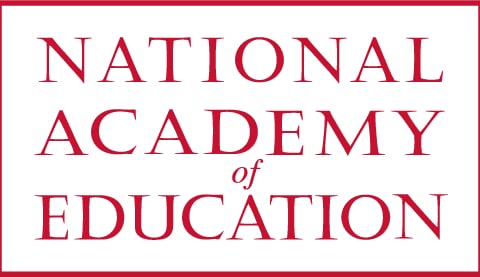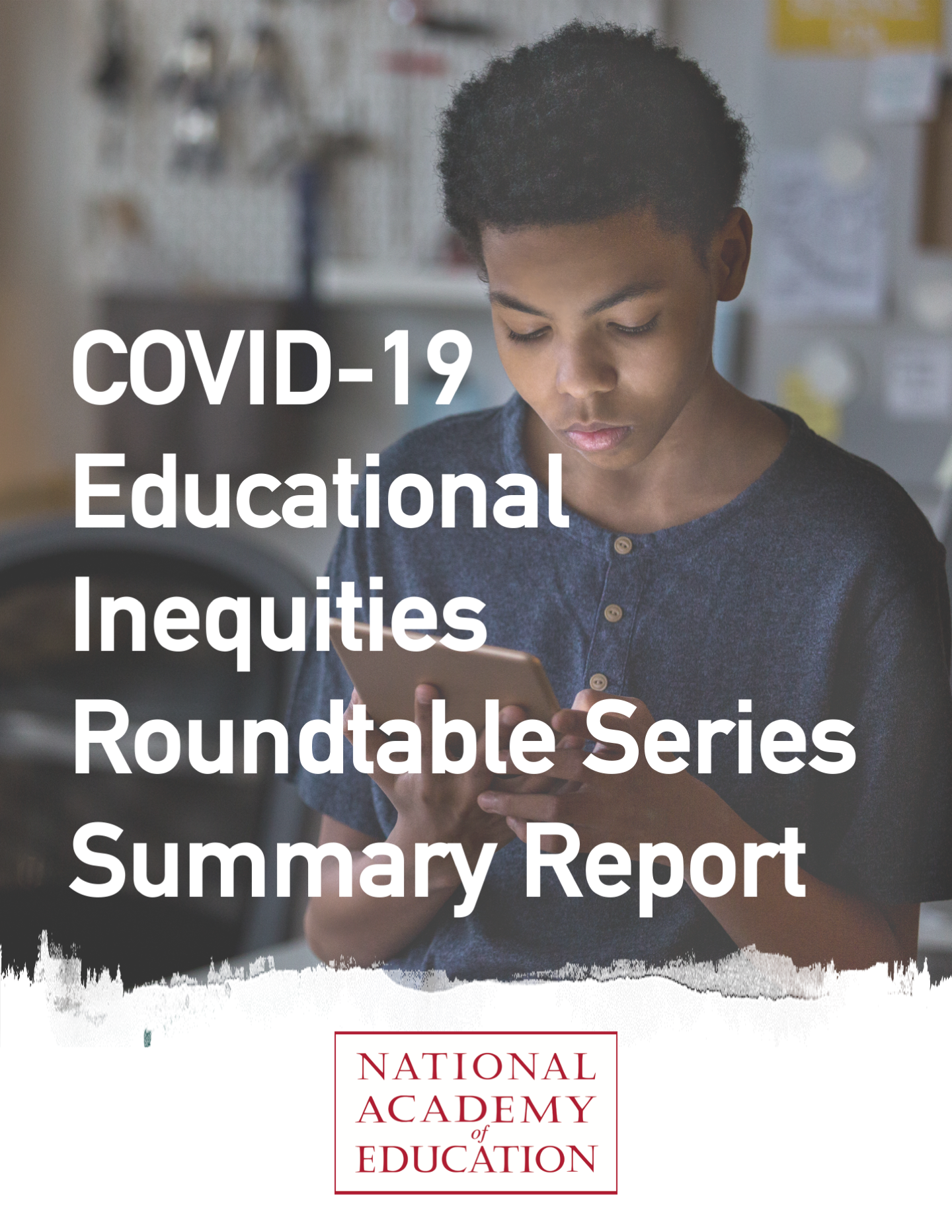COVID-19 Educational Inequities Roundtable Series
Back to project pageSummary Report
INTRODUCTION
The National Academy of Education (NAEd) convened groups of scholars, policy leaders, and educators to address this fundamental question: how do we address educational inequities in the face of the COVID-19 emergency, a challenge made even more urgent in the context of the resurgent American crisis of racial justice?
CHALLENGES TO ACADEMIC LEARNING AND SOCIAL-EMOTIONAL DEVELOPMENT
Since March 2020, with two crises – COVID-19 and the awakening for many Americans of ongoing racial injustice – the American education system as we know it has been disrupted and students’ academic and social-emotional learning have been affected. During the NAEd discussions, practicing educators and researchers identified the following key concerns:
- Structural impediments and uneven access to online learning, including problems of technology and the need for new forms of family support;
- Disruption in student engagement with school leaders, teachers, and peers that may threaten mental well-being as well as academic engagement;
- Limited and disrupted access to mental health supports;
- Difficulties in online learning for special populations, particularly young children, children with disabilities and special learning needs, English learners, and students in home environments not conducive to online learning;
- Barriers to effective communication with families and care-givers, which cause additional stress on teachers and students;
- Challenges to teachers and staff necessitating additional professional development; and
- Attending to well-being of teachers and staff whose lives have been disrupted by the pandemic.
TAKEAWAYS: MESSAGES AND ADVICE
It would be presumptuous to suggest that the NAEd has “answers” to these daunting problems. However, it is possible to outline a set of “best bets,” i.e., strategies and action steps that are likely to advance the possibility for improved learning as the crisis continues – and beyond. This list is not meant as a “consensus” set of findings or recommendations, but rather as an invitation to continued research and deliberation. If there is a theme that is woven through these suggestions it may be best summarized in the words of Mathew Portell, principal at Fall Hamilton Enhanced Option School, Tennessee, quoted by one of the discussants in the NAEd sessions: “My biggest fear is that everything changes… and my second biggest fear is that nothing changes…”
Takeaways in this report include three categories: (1) basic necessities, (2) academic learning, and (3) whole person well-being.
Basic Necessities
1. Ensure the children who would be provided with meals at school continue to receive food.
2. Reach families that the school has not had contact with since the outbreak of the pandemic ended in-person learning.
3. Ensure access to technology.
4. Focus on the social emotional well-being of students and staff.
Academic Learning
1. Engage and collaborate with the entire school community to focus on learning.
2. Recognize that the pandemic will continue to affect schools and school districts differently, and there is no “one-size-fits-all” solution.
3. Do not rush to address all unfinished curricular learning needs in academic year 2020-21.
4. Begin curriculum planning with the assets, interests, curiosities, aspirations, and fears of students.
5. Provide “grade-level content and instructional rigor.”
6. Provide teachers with support, professional development, and professional learning communities.
7. Recognize teachers’ efforts as they work to educate children through these challenging times.
8. Use formative assessments to further teaching and learning and provide effective, meaningful feedback to students.
Whole Person Well-Being
1. Make the social emotional and mental health needs of students and staff the top priority.
2. Build social emotional learning into the school curriculum for all students.
3. Provide ongoing consultation to teachers and families on challenges that they are facing in responding to children’s needs.
4. Provide group and individual sessions with mental health personnel (counselors, social workers, school psychologists) for students experiencing distress.
5. Determine strategies for maintaining, strengthening, and developing relationships in a virtual environment.
LIST OF USEFUL RESOURCES
American Academy of Pediatrics. (2020). COVID-19 Planning Considerations: Guidance for School Re-entry.
Collaborative for Academic, Social, and Emotional Learning (CASEL). (2020). Reunite, Renew and Thrive: SEL Roadmap for Reopening School.
Council of Chief State School Officers. (2020).
- Restart & Recovery: Considerations for Teaching & Learning Overview.
- Restart & Recovery: Serving English Language Learners During COVID-19.
Council of the Great City Schools. (2020).
- Addressing Unfinished Learning After COVID-19 School Closures.
- Addressing Mental Health and Social-Emotional Wellness in the COVID-19 Crisis: A Resource Guide for School Districts.
eSchool+ Initiative. Resources for Reopening Schools. The Johns Hopkins University.
Kelly, M. S., Astor, R. A., Benbenishty, R., Capp, G., & Watson, K. R. (2020).UCLA Luskin School of Public Affairs, Department of Social Work.
- Opening Schools Safely in the COVID-19 Era: School Social Workers’ Experiences and Recommendations Technical Report.
- Opening Schools Safely in the COVID-19 Era: School Social Workers’ Experiences and Recommendations, Policy Brief.
National Academies of Sciences, Engineering, and Medicine. (2020). Reopening K-12 Schools During the COVID-19 Pandemic: Prioritizing Health, Equity, and Communities. Washington, DC: The National Academies Press. https://doi.org/10.17226/25858.
National Council of Teachers of Mathematics. (June 2020). Moving Forward: Mathematics Learning in the Era of COVID-19.
Stand for Children Leadership Center. (2020). Preventing a Lost School Year: The Crucial Importance of Motivating Students & Engaging Families.
STEERING COMMITTEE MEMBERS AND PANELISTS
For full description of the project, please visit our project page.
For inquiries, contact Amy Berman, Deputy Director (aberman@naeducation.org), or Dian Dong, Senior Program Officer (ddong@naeducation.org).
This study was supported by a grant from the Spencer Foundation. Any opinions, findings, conclusions, or recommendations expressed in this publication are those of the National Academy of Education and the authors and do not necessarily reflect the views of the Spencer Foundation.
school closures on student academic achievement. NWEA Research; World Bank Group (2020). Simulating the potential impacts of
COVID-19 school closures on schooling and learning outcomes: A set of global estimates. Retrieved from:
http://pubdocs.worldbank.org/en/798061592482682799/covid-and-education-June17-r6.pdf
2 Alexander, K. L., Entwisle, D. R., & Olson, L. S. (2007). Lasting Consequences of the Summer Learning Gap. American Sociological Review, 72(2), 167–180. https://doi.org/10.1177/000312240707200202
3 Sacerdote, B., (2012). When the Saints go marching out: Long-term outcomes for student evacuees from Hurricanes Katrina and Rita. American Economic Journal: Applied Economics, 4(1), 109-35; Harris, D. N., & Larsen, M. F. (2018). “The Effects of the New Orleans Post-Katrina Market-Based School Reforms on Student Achievement, High School Graduation, and College Outcomes.” Education Research Alliance for New Orleans.
4 Duncan, G. J., & Murnane, R. J. (Eds.) (2011). Whither opportunity? Rising inequality, schools, and children’s life chances. New York: Russell Sage Foundation; Darling-Hammond, L. (2001). Inequality in Teaching and Schooling: How Opportunity Is Rationed to Students of Color in America. The Right Thing to Do, The Smart Thing to Do: Enhancing Diversity in Health Professions — Summary of the Symposium on Diversity in Health Professions in Honor of Herbert W. Nickens, M.D.. Washington, DC: The National Academies Press. https://doi.org/10.17226/10186.

